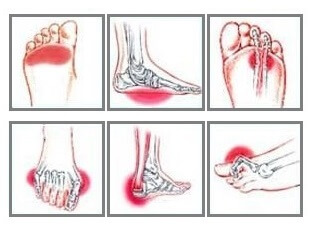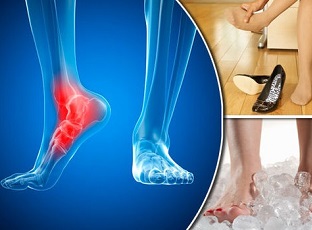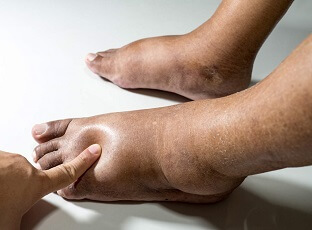- Home
- Diagnosis Guide
- Diagnosis Chart
Foot Pain Diagram
Written By: Chloe Wilson BSc(Hons) Physiotherapy
Reviewed By: FPE Medical Review Board
A foot pain diagram is a great tool to help you work out what is causing your ankle and foot pain. There are a whole range of structures e.g. bones, muscles, tendons and nerves which will each give slightly different foot pain symptoms.
The foot pain charts you find here will help you to identify the possible causes of your foot problem and then help you find out everything you need to know about the causes, symptoms, diagnosis and best treatment options for each.
The first foot pain diagram looks at the front and top of the foot, the second foot pain chart looks underneath and at the back of the foot.
Front Foot Pain Chart
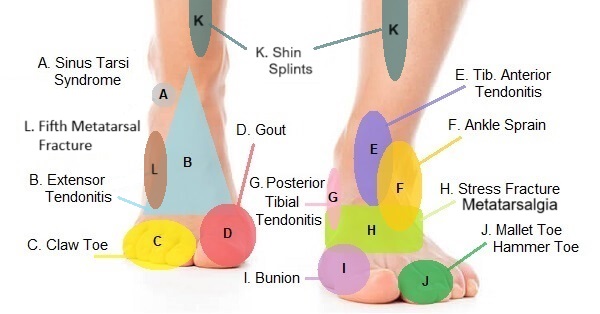
This foot pain diagram shows common problems that cause pain on top of the foot at the front.
A. Sinus Tarsi Syndrome
Inflammation and instability causing pain deep inside the joint that gets worse with activity, especially ankle twisting, and better with rest. Sinus Tarsi Syndrome is often the cause of ongoing foot pain following an ankle sprain. Learn More >
B. Extensor Tendonitis
Extensor tendonitis is caused by Inflammation and irritation of the tendons across the top of the foot and is the most common cause of top of foot pain. Pain when resisting toe extension (lifting the toes up) indicates tendonitis. Learn More >
C. Claw Toe
With Claw Toe, muscle tightness and weakness, ill-fitting footwear or previous injuries cause the outer four toes to abnormally curl into different positions. Learn More >
D. Foot Gout
Foot gout is a type of inflammatory arthritis causing sudden intense pain, swelling and redness typically in the big toe. Symptoms typically flare up at night. Learn More >
E. Tibialis Anterior Tendonitis
Inflammation of the tendon across the front of the ankle causes top of foot pain typically when walking down stairs or on slopes. Learn More >
F. Ankle Sprain
Overstretching of one of the ankle ligaments causing it to tear. Leads to ankle pain and instability. 85% of ankle injuries are ligament sprains. Learn More >
G. Posterior Tibial Tendonitis
Inflammation and/or tearing of the tendon that supports the foot arch. Posterior tendonitis makes it difficult to stand on tiptoes and causes pain and swelling on the inner ankle. Learn More >
G. Accessory Navicular Syndrome
Irritation of a small extra bone that sits at the top of the inner foot arch. Causes pain, swelling and a hard lump in the foot arch and makes walking difficult. Learn More >
H. Stress Fractures
Small breaks in the foot bones, most typically the metatarsals, due to repetitive overloading. Often linked with sudden increases in activity levels. Learn More >
I. Bunions
Big toe shifts inwards causing the outer side of the toe to stick out gradually more and more. Most common in women who wear high heels and pointy shoes. Learn More >
I. Hallux Rigidus
Stiffness in the big toe, "hallux rigidus" can result in inflammation, pain and reduced motion in the big toe, affecting activities such as walking. Most common over the age of 50. Learn More >
J. Mallet Toe & Hammer Toe
Deformities in the different toe joints that cause abnormal bending of the toes, most typically affecting the second toe. Learn More >
K. Shin Splints
Overuse injury, common in runners, causing pain along the inner edge of the lower shin. Usually starts after sudden increase in activity levels. Learn More >
L. Fifth Metatarsal Fractures
There are lots of different types of fracture of the fifth metatarsal, depending on where the bone breaks. Usually caused by twisting injuries or awkward landing. Learn More >
Bottom Of Foot Pain Diagram
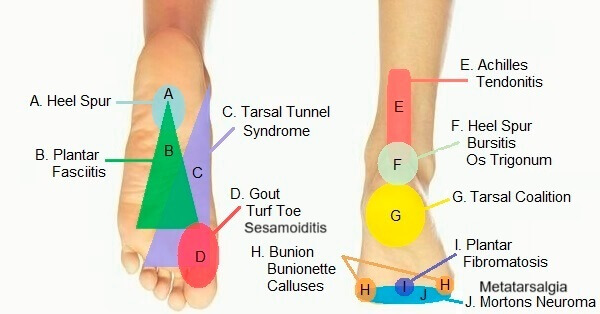
This foot pain diagram looks at the common causes of pain under the foot and at the back of the heel.
A. Heel Spurs
A bone spur here is called an inferior calcaneal bone spur and is usually linked with a tight plantar fascia. Causes a sharp pain under the foot that is worse with initial movement then eases to a dull ache. Learn More >
B. Plantar Fasciitis
Tightness and repetitive strain can lead to inflammation and tearing of the plantar fascia. Foot pain stems from the heel and radiates under the foot. Worse when you first start to walk, standing on tiptoes and walking up stairs. Learn More >
C. Tarsal Tunnel Syndrome
With tarsal tunnel syndrome, a nerve gets squashed underneath the inner ankle causing shooting or burning heel and foot arch pain, tingling and numbness. Learn More >
D. Gout Foot
Build-up of uric acid crystals in the big toe joint causes very intense toe pain, swelling and redness. Gout symptoms typically develop suddenly at night and last for a few weeks. Learn More >
D. Turf Toe
Turf Toe is a sprain of the big toe caused by the toe bending back too far. It results in pain and swelling in the big toe. Common injury in sports people playing on artificial turf. Learn More >
D. Sesamoiditis
Sesamoiditis is where there is inflammation of the two pea-sized bones that sit underneath the big toe and their surrounding tendon. Causes pain and tenderness under the big toe with walking, running and jumping. Learn More >
E. Achilles Tendonitis
Repetitive strain leads to tearing and degeneration of the Achilles tendon. Usually caused by calf muscle tightness or sudden increases in activity levels. You can often a hard lump in the tendon and the calf and ankle become stiff and tight. Learn More >
F. Heel Spurs
A bone spur on the back of the heel is known as Haglunds Deformity. Causes heel pain, swelling and redness and a hard lump often forms. Commonly associated with Achilles Tendonitis and Bursitis. Learn More >
F. Heel Bursitis
Inflammation of the bursa behind the heel is called Retrocalcaneal Bursitis. Repetitive pressure or friction over the back of the heel causes the bursa to swell resulting in heel pain and tenderness, swelling and ankle stiffness. Often associated with Achilles Tendonitis and Haglunds Deformity. Learn More >
F. Os Trigonum
An Os Trigonum is a small extra bone in the back of the ankle found in 5-10% of people. Causes tenderness and pain behind the ankle particularly when pointing the toes or going up on tiptoes and sometimes swelling. Typically symptomatic in ballet dancers, runners and football players, or after an ankle injury. Learn More >
G. Tarsal Coalition
Tarsal Coalition is where a bony bridge forms between the heel bone and one of the tarsal bones. Causes foot and ankle pain and stiffness that is worse when you are on your feet, muscle spasms and flat feet. Typically affects children aged 10-15. Learn More >
H. Bunions & Bunionettes
These are where one of the toes starts to deviate inwards causing the base of the toe (like the knuckle) to stick outwards. Typically affects the big toe, known as a bunion, but can affect the little toe, known as a bunionette. Most common in women who wear tight, pointy, high heeled shoes. Learn More >
H. Calluses & Corns
Areas of thickened, hard skin caused by excessive friction or pressure through the foot. Calluses can get quite large and are usually white and painless whereas corns are smaller, circular in shape, more yellowy and can be quite painful. Learn More >
I. Plantar Fibromatosis
A Plantar Fibromatosis is a benign growth forming a hard nodule that can be felt in the arch of the foot. It may or may not cause foot arch pain and plantar fascia tightness. Learn More >
J. Morton’s Neuroma
With a Morton’s Neuroma it often feels like you have a small stone in your shoe. A benign growth develops on one of the nerves forming a lump between two toes known as a fibroma. It causes a sharp, stabbing pain in the ball of the foot as well as tingling and numbness. Learn More >
J. Metatarsalgia
Metatarsalgia occurs where there is irritation and inflammation underneath the metatarsal heads. This results in pain in the ball of the foot. It is usually caused by repetitive overuse, altered foot biomechanics or ill-fitting footwear. Learn More >
There are other things that can cause pain under the foot not shown on this foot pain diagram, such as foot cramps and stress fractures which you can find out all about in the Foot Arch Pain section.
Foot Pain Symptoms
If you are struggling to work out what is causing your pain from the foot pain diagnosis, it can help to think about the other symptoms that are associated:
- Altered Sensation & Nerve Pain
- Swollen Feet & Ankles
- Burning Foot Pain
- Muscle Cramps
- Foot Pain When Running
- Foot Blisters
- Foot Rashes
- Foot Numbness
- Foot Lumps & Bumps
- Sharp Pain In Big Toe
- Toenail Problems
- Morning Foot Pain
What Else Can Help?
Understanding what is causing your foot pain is the first step to treating it. Each foot pain diagram here is a useful visual tool for diagnosing what is wrong in your foot or ankle. Alternatively, check out the following articles:
Once you have identified the cause of your problem from these foot pain diagrams, you can find out loads more about the causes, symptoms, diagnosis and treatment options for each by using the links above.
There are other common causes of foot and ankle pain not seen on the foot pain diagrams here such as Trench Foot and Foot Cramps but these tend to give more general symptoms throughout the foot rather than causing pain in specific places as shown on these foot pain diagnosis charts.
Related Articles
Page Last Updated: 9th December, 2024
Next Review Due: 9th December, 2026
